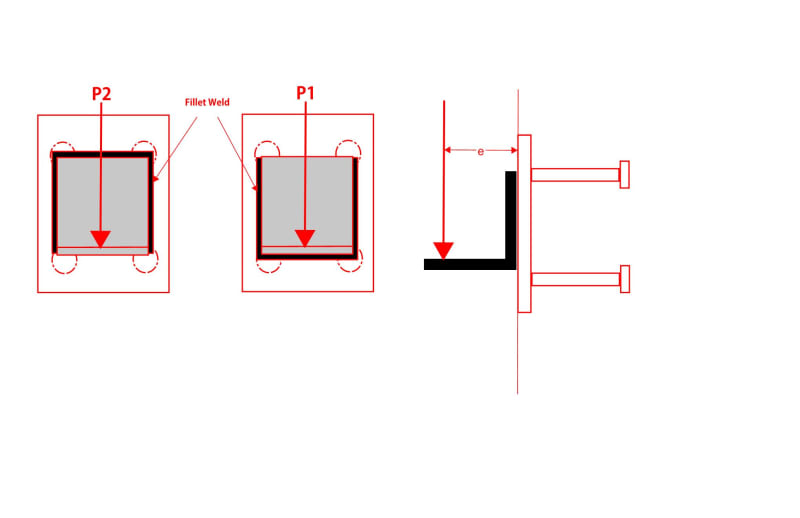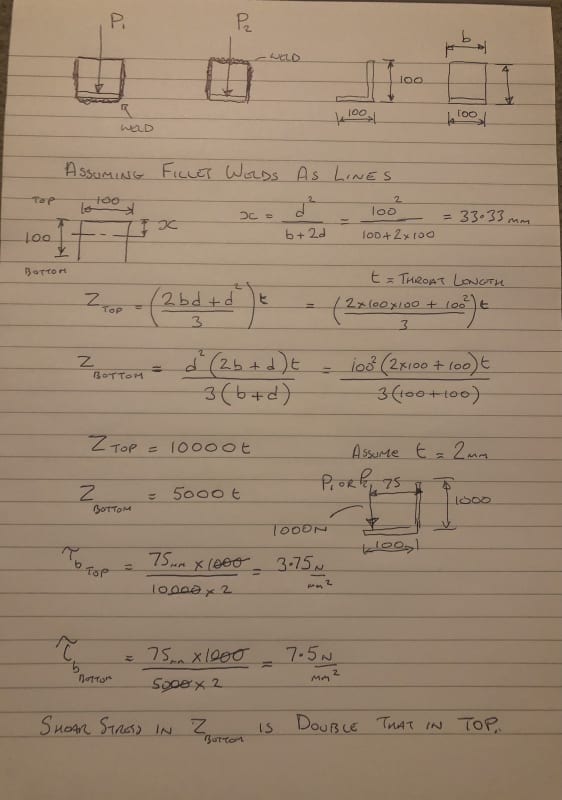-
1
- #1
Navigation
Install the app
How to install the app on iOS
Follow along with the video below to see how to install our site as a web app on your home screen.
Note: This feature may not be available in some browsers.
More options
Style variation
-
Congratulations cowski on being selected by the Eng-Tips community for having the most helpful posts in the forums last week. Way to Go!
You are using an out of date browser. It may not display this or other websites correctly.
You should upgrade or use an alternative browser.
You should upgrade or use an alternative browser.
Welding Capacity Calculation 7
- Thread starter JohnRwals
- Start date
- Status
- Not open for further replies.
BA's case reveals the inefficiency of the weld arrangement of P1 case offered by OP, but does not overturn the weld strength calculations based on literatures. It is too far to say P1 has zero capacity though, unless vertical welds are not considered.
According to the elastic method of weld analysis, it’s the two vertical welds where there is no horizontal weld, that will fail first irrespective of whether P1 or P2 is used.
“Do not worry about your problems with mathematics, I assure you mine are far greater.” Albert Einstein
“Do not worry about your problems with mathematics, I assure you mine are far greater.” Albert Einstein
Sounds like a good argument for not having vertical welds, but with P1 and P2, the vertical welds are in tension and compression respectively at their maximum value. I would have thought the weld is less likely to fail when in compression.
BA
BA
I’ve picked some figures and loads randomly for the purpose of illustration in the post above.
If the weld is turned to position P2 then the Z values are just reversed. The neutral axis for the weld outline is located 33.3mm below the horizontal weld, so the vertical legs always have the lower value of Z whether they point up or down, so for any given loading the will always carry the higher stress.
“Do not worry about your problems with mathematics, I assure you mine are far greater.” Albert Einstein
If the weld is turned to position P2 then the Z values are just reversed. The neutral axis for the weld outline is located 33.3mm below the horizontal weld, so the vertical legs always have the lower value of Z whether they point up or down, so for any given loading the will always carry the higher stress.
“Do not worry about your problems with mathematics, I assure you mine are far greater.” Albert Einstein
desertfox said:The neutral axis for the weld outline is located 33.3mm below the horizontal weld, so the vertical legs always have the lower value of Z whether they point up or down, so for any given loading the will always carry the higher stress.
The maximum weld stress always occurs at the open end of the vertical weld, but with P1, it is preventing the angle from separating from the embed plate whereas with P2, it is preventing the angle from closing an imagined gap between itself and the embed plate. An unzipping, it seems to me, is more likely to occur with P1 than with P2.
BA
I wouldn’t disagree with you on that BA but as I stated way back provided we size the weld based on the lower Z value then for a given loading,P1 would be okay but it’s not the best use of the material.
“Do not worry about your problems with mathematics, I assure you mine are far greater.” Albert Einstein
“Do not worry about your problems with mathematics, I assure you mine are far greater.” Albert Einstein
- Status
- Not open for further replies.
Similar threads
- Replies
- 8
- Views
- 14K
- Replies
- 7
- Views
- 3K
- Replies
- 56
- Views
- 16K
- Locked
- Question
- Replies
- 9
- Views
- 2K
- Replies
- 8
- Views
- 5K


